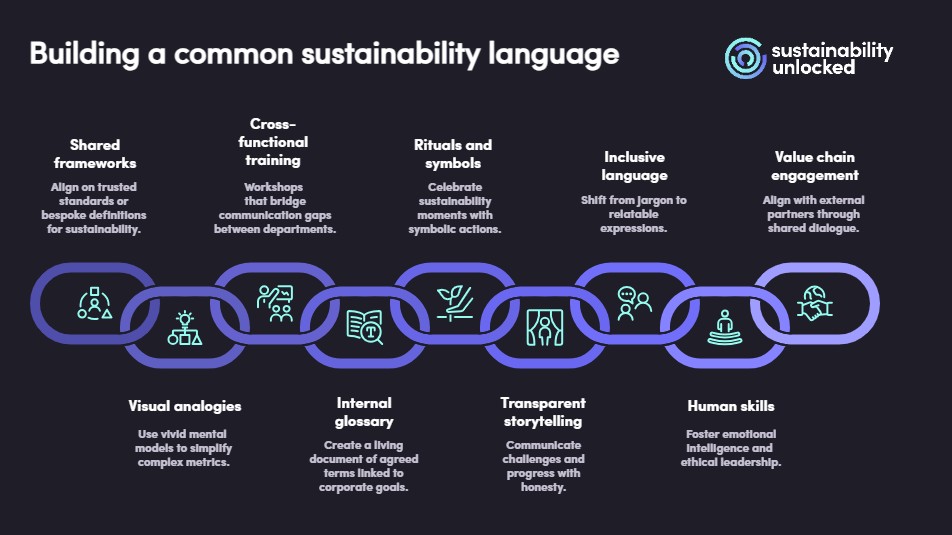
Nine ways to build a common language in sustainability

Learning Adviser
How to embed a shared language to achieve firm-wide sustainability goals

In sustainability, a common language — shared understanding, terminology, frameworks, and analogies — plays a vital role in bridging the gap between your organisation’s sustainability experts (1%) and your broader organisation (99%). It also underpins collaborative action, allowing separate business units to come together and move at scale to effect change.
Without it, sustainability risks remaining fragmented, misunderstood, or siloed — just at a time when success relies on the workforce understanding, and acting on, the intersectionality of sustainability issues: biodiversity, climate, food, water, jobs, transport, economy, business, and people. A unified language aligns teams across finance, operations, risk, HR, marketing, and more, enabling better communication, collaboration, and collective action.
If everyone understands the “why”, “what” and “how”, they spend less time deciphering what something means, and more time acting on it. This is critical in high-pressure scenarios where regulatory changes, sustainability reporting cycles, or supply chain disruptions are important, firm-wide responsibilities. It also helps avoid ambiguity that breeds risk, and helps transform sustainability from an abstract concept into a practical organisation-wide capability that unlocks value.

How to drive a common language in sustainability: Your route to success
- How can we choose and embed a shared sustainability framework? Align around trusted standards — such as those from the Global Reporting Initiative (GRI), the Sustainability Accounting Standards Board (SASB), or the International Sustainability Standards Board (ISSB) — or develop a bespoke set of definitions for sustainability. Clarify what “materiality,” “net zero,” or “regenerative” specifically mean in the context of your business.
- How do we agree the terms of a common language on sustainability? Build a glossary and champion it. Develop a living internal glossary of agreed terms, linked with your corporate goals and case studies. Promote it regularly through learning modules, town halls, and internal channels, reinforcing usage and consistency.
- How can we simplify the way we talk about sustainability in our business? Use analogies and visuals. Turn complex metrics into vivid mental models. In our Sustainability Unlocked video, Interpreting Carbon Calories, environmental scientist and ESG leader Michelle Horsfield provides a perfect example of this, describing a “tonne of carbon dioxide” as looking like two oil drums filled with petrol and set alight. Supported by striking graphics, this approach helps generate a sense of scale: when we consider the average household in the US burns through 28 tonnes of carbon dioxide a year, compared to just 1.3 per household in India, you can envisage exactly what this means. It makes sustainability memorable, accelerating comprehension.
- What are the best ways to communicate our sustainability progress? Model transparent, authentic storytelling. Encourage leadership and sustainability ambassadors to communicate in plain language — acknowledging challenges, progress, and failures. Be consistent, avoid greenwashing, and speak with clarity to build credibility. Remember ESG is a journey. As Maria Coronado Robles, Head of Sustainability Content at xUnlocked says in her recent interview with Santander Navigator, “ESG isn’t about claiming perfection. It’s about showing intent, making progress, and being honest about the course corrections needed along the way.”
- How can we communicate in a way that unblocks internal silos? Help dismantle internal barriers with cross-functional communication workshops. Bring together finance, sustainability, operations and HR to role-play and explain concepts in each other’s language. Focus on translating technical terms into business-relevant insights, boosting interdisciplinary fluency, and use real-world examples, relevant to your people and business, to bridge the gap between theory and practice.
- How can we ensure people are fully engaged with our sustainability messaging? Use rituals and symbols to reinforce understanding. Celebrate sustainability moments — “Impact Fridays”, planting ceremonies, supplier tours — as rituals that reinforce shared terminology and values. Symbols (like icons for carbon, water, biodiversity) create visual shorthand rooted in your language.
- What specific language should we be using in our sustainability messaging? Language shapes culture. When you shift from jargon or warlike metaphors (“combatting climate change”) to inclusive, relatable expressions (“building regenerative futures”), you invite broader engagement, which helps sustain momentum.
- How can we inspire a firm-wide shared sense of responsibility and collaboration to meet sustainability goals? Use frameworks like the Inner Development Goals (IDGs) to foster emotional intelligence and resilience, empathy, and a sense of firm-wide responsibility, which are crucial to navigating complex environmental and social challenges. The IDGs support the idea that true sustainability requires both technical solutions and a human-centered approach, inspiring collaboration and ethical leadership essential for lasting impact. For more insights into embedding IDGs, see another of Michelle’s videos at Sustainability Unlocked: Enabling Change in Your Company.
- How can a common language help address sustainability blocks in our client and supplier relationships? Engage your value chain through shared dialogue. Activate sustainability language beyond your four walls — align with suppliers, customers, and external partners through joint definitions, expectations, and collaborative platforms. Think beyond your own people to break down silos across your networks.
How Sustainability Unlocked helps
A common sustainability language transforms abstraction into action. It equips everyone — from boardrooms to supply chains — with the clarity and confidence to embed sustainability into decisions, strategies, and outcomes. It breaks down silos, strengthens collaboration, and integrates environmental priorities into business as usual.
At Sustainability Unlocked, we integrate all these elements into our learning pathways — framework alignment, cross-functional workshops, glossary tools, rituals, storytelling techniques, and mindset training — to help you:
- Co-create a sustainability vernacular that resonates across your business
- Build the critical thinking and communication muscle for adaptive action
- Bridge internal and external networks through shared understanding
- Embed ritual and structure to sustain language and culture over time
If you're ready to turn your sustainability language into your greatest strategic asset, we’d love to support your journey. Contact us now to find out more.
Share "Nine ways to build a common language in sustainability" on
Latest Insights

Rethinking AI: Unlocking business value, shaping humanity's future
15th August 2025 • xUnlocked

Are knowledge gaps or disparities blocking your sustainability success?
10th June 2025 • Maria Coronado Robles



